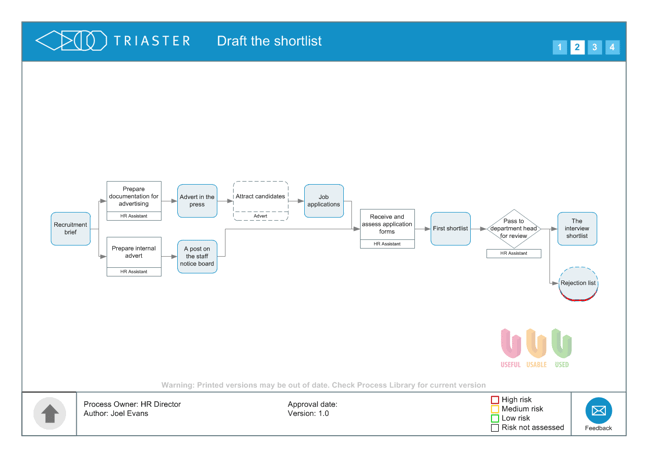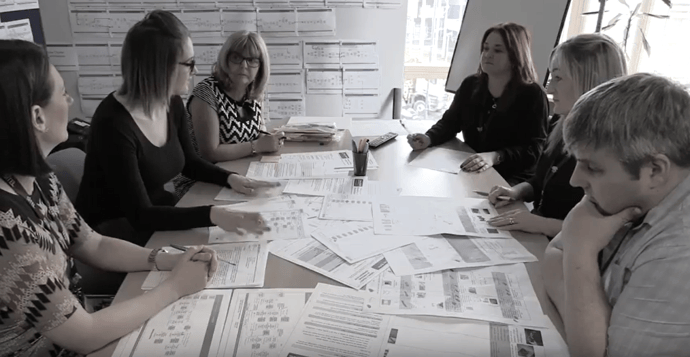Triaster customers who are keen to increase staff engagement with their Business Processes tend to ask the same question: “How do I get people to take ownership of their processes?” This article will explain how your organisation can achieve just that.
Ownership and Accountability Issues
When chatting with customers we often hear: 'we struggle with accountability', 'people are not held accountable' and ''we have tried to embed a culture of accountability numerous times before with no success'. These are all ways of saying that process ownership is poor or absent in their organisation.
To help you to overcome this, we cover the following in this article - feel free to skip to the section most relevant to you:
- Capture and Document your Business Processes
- Document Process Ownership
- Communication Drives Engagement
- Increase Staff Engagement
- Keep your Process Documentation Current
- Build Process Ownership into your Systems
Capture and Document your Business Processes
It is much easier to get people to take ownership of their processes if they know what they are, and even more so if they have played a part in capturing and documenting them.
However you document a process, it is important to involve the people who are responsible carrying out the process day-to-day. For more information on how to capture a process, please read our article Capturing a Business Process: 3 tips for Process Discovery workshops.

A very common way to document a process is by process mapping. For information on process mapping, please read our article: Process Mapping: who does it and why?
Document Process Ownership
Whilst capturing and documenting your processes, it is important to also capture who the Process Owner is for each process. If you are unsure who exactly the process owner is, at Triaster we define a Process Owner as ‘a person who has the authority to change a process’. So, who would be the person in your organisation to change the process? They are the Process Owner. Don't document their name however, but their job title - as in the process map above where the HR Director is shown as the Process Owner - as the responsibility lies with the job role. It also ensures that when the persons in that role changes, the documentation does not need to be updated.
With process maps, the Process Owner can be captured in the metadata. This just means adding specific data to your process maps about who the Process Owner is so that this is clearly identified and visible. To do this, compile a list of the Process Owners in your organisation and attach their corresponding job roles to the process maps. This way, the person responsible for the process is absolutely clear - to everyone, including them!
Communication Drives Engagement
Having established who your Process Owners are, it is important to communicate what is expected of them. Your Process Owners will have all sorts of improvement ideas in mind and the ability to drive them forward will drive engagement and ownership. However, a framework approach is needed to ensure that improvements are in line with the overall business strategy and approach. For example:
- Is your organisation implementing Continuous Improvement?
- Do the process owners have senior support to implement incremental improvements to their processes?
This needs to be clarified and communicated.
Increase Staff Engagement with a Business Management System
Capturing the organisation’s end-to-end processes and the Process Owners is not enough on its own however. It is important that this information is visible to the whole organisation. The easiest way to do this is with a system that is accessible to the whole organisation and is easy to use - with excellent search and reporting capabilities - so therefore is used.
A great example of a Business Management System (BMS) can be found here: Triaster Process Library.

Keep your Process Documentation Current
Given that your process documentation is the key source of information on how your organisation works and who is responsible for what, it is important to keep them up-to-date and accurate. We recommend that all processes are reviewed once a year, and that this is the Process Owners’ responsibility. Building in review of the actual process at the same time, drives continual improvement and process ownership by making the exercise a real value add.
Build Process Ownership into your Systems
However you approach documenting and sharing your processes, ensuring everyone knows what your processes are and who is the Process Owner for each process, is without a doubt, the best way to increase staff engagement and ownership.
Even with a great BMS in place however, people can forget who the Process Owner is for a particular project - even if they are the Process Owner!
So it's important to build who the Process Owners are into your systems as well, to embed process ownership into everyday working.
Triaster's Ask The Crowd can be used by both organisations that have their processes mapped out and a BPM system in place, and also smaller organisations for whom this is too much of an overhead. Whichever type of organisation you work for, Ask The Crowd will build your processes and process ownership into your standard way of working in a very straightforward way.
With Ask The Crowd each input is given an owner so it couldn't be clearer who is responsible for moving the input through the process. With this in place everyone automatically takes ownership of their inputs - and process ownership is standard practice.
It is amazingly simple and incredibly effective.
Related articles:
Process Mapping: Who does it and why?
How do I create a culture of Continuous Improvement?
Problems with Business Process Management: Getting Employee Buy In
Note:
This is an updated and refreshed version of an article originally written in 2017.
Written by Carma Evans
Carma Evans is now Triaster's General Manager. During her many years with the company she has fulfilled many roles and there is not much that she doesn't know about driving business improvement.

